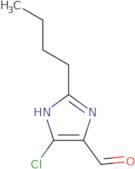
2-Butyl-4-chloro-1H-imidazole-5-carboxaldehyde
CAS : 83857-96-9
Ref. 3D-FB19493
| 25g | 187,00 € | ||
| 50g | 311,00 € | ||
| 100g | 469,00 € | ||
| 250g | 794,00 € | ||
| 500g | 1.125,00 € |
Informations sur le produit
- 2-Butyl-5-chloro-1H-imidazole-4-carboxaldehyde2-Butyl-4-chloro-5-formylimidazole2-Butyl-4-chloroimidazole-5-carboxaldehyde
- (2-n-Butyl-5-Chloro-imidazole-4-yl)-Carboxaldehyde
- 1H-Imidazole-4-carboxaldehyde, 2-butyl-5-chloro-
- 2-Butyl-4-Chloro-1H-Imidazole-5-Carbaldehyde
- 2-Butyl-4-Chloro-1H-Imidazole-5-Carboxaldehyde
- 2-Butyl-4-Chloro-1H-imidazo-5-Carboxaldehyde
- 2-Butyl-4-Chloro-5-Imidazole Carboxaldehyde
- 2-Butyl-4-Chloro-5-Imidazolecarboxaldehyde
- 2-Butyl-4-Chloro-5-formyl imidazole
- 2-Butyl-4-Chloro-5-formylimidazloe
- Voir d'autres synonymes
- 2-Butyl-4-Chloro-5-formylimidazole
- 2-Butyl-4-Chloro-Imidazole-5-Carbaldehyde
- 2-Butyl-4-chloro-1-H-imidazole-5-carboxaldehyde
- 2-Butyl-4-chloro-1H-imidazolyl-5-carboxaldehyde
- 2-Butyl-4-chloro-5-formylimidazole(BCFI)
- 2-Butyl-4-chloroimidazole-5-carbaldehyde
- 2-Butyl-4-chloroimidazole-5-carboxaldehyde
- 2-Butyl-5-Chloro-1H-Imidazole-4-Carbaldehyde
- 2-Butyl-5-Chloroimidazole-4-Carboxaldehyde
- 2-Butyl-5-chloro-3H-imidazole-4-carboxaldehyde
- 2-Butyl-5-chloro-4-formylimidazole
- 2-Butyl-5-chloroimidazole-4-carbaldehyde
- 2-Butyl-5-formyl-4-chloroimidazole
- 2-n-Butyl-4-Chloro-1H-Imidazole-5-Carboxaldehyde
- 2-n-Butyl-4-chloro-5-imidazolecarboxaldehyde
- 2-n-Butyl-5-chlorimidazole-4-carbaldehyde
- 4-Chloro-2-n-butylimidazole-5-carboxaldehyde
- Bcfi
- 2-Butyl-5-chloro-1H-imidazole-4-carboxaldehyde
Glyoxal is a chemical compound that has shown to have bactericidal activity against human pathogens such as Mycobacterium tuberculosis, Helicobacter pylori, and Staphylococcus aureus. It is used in the synthesis of heterocyclic amines and can be found as an impurity in imidazole derivatives. Glyoxal is a broad-spectrum antimicrobial that has been shown to inhibit the growth of fungi and bacteria by reacting with functional groups on the microorganisms' cell walls. It reacts with bacterial cell walls by forming an intermediate molecule, which reacts with other molecules present in the microorganism's environment to form carbon dioxide, water, and glyoxal. The reaction time for glyoxal depends on temperature; higher temperatures will result in faster reactions. Techniques used to synthesize glyoxal include dehydration of oximes or by reaction with phosphorus oxychloride.
Propriétés chimiques
Question d’ordre technique sur : 3D-FB19493 2-Butyl-4-chloro-1H-imidazole-5-carboxaldehyde
Si vous souhaitez demander un devis ou passer commande, veuillez plutôt ajouter les produits souhaités à votre panier, puis demander un devis ou passer commande à partir de votre panier. C'est une méthode plus rapide, plus économique, et vous pourrez bénéficier des remises disponibles ainsi que d'autres avantages





